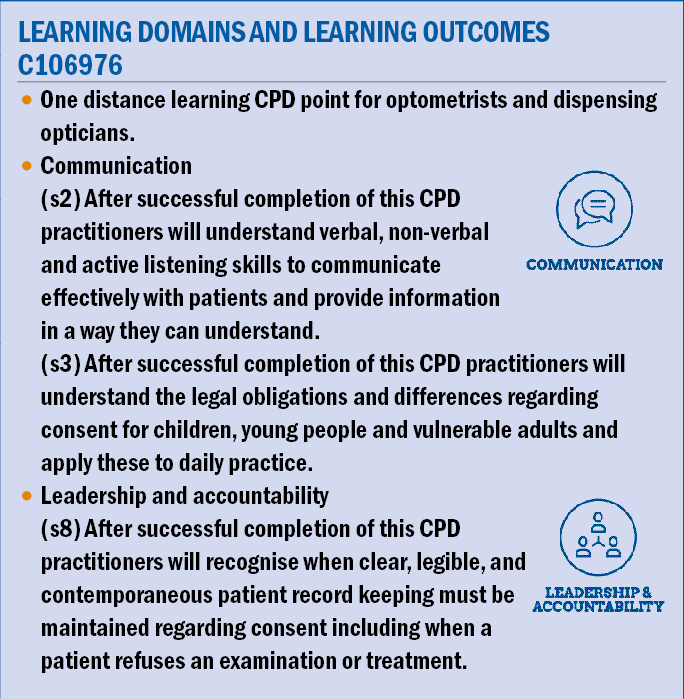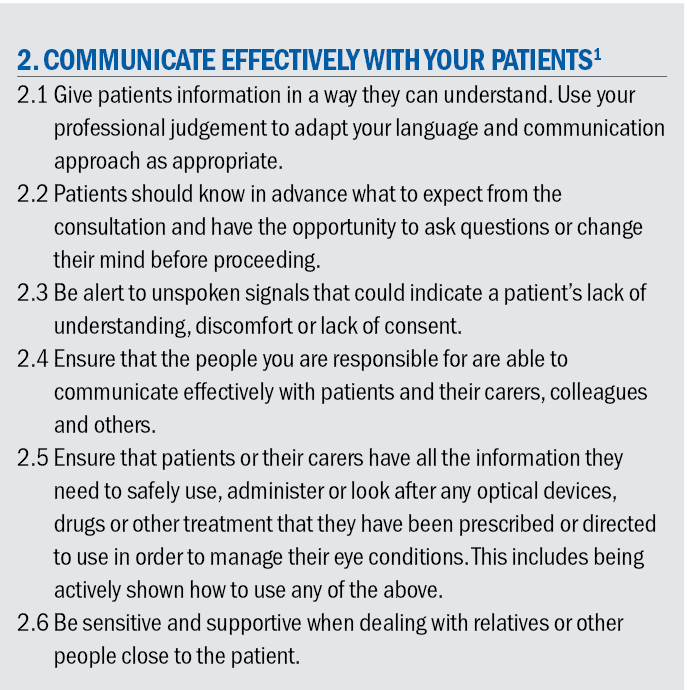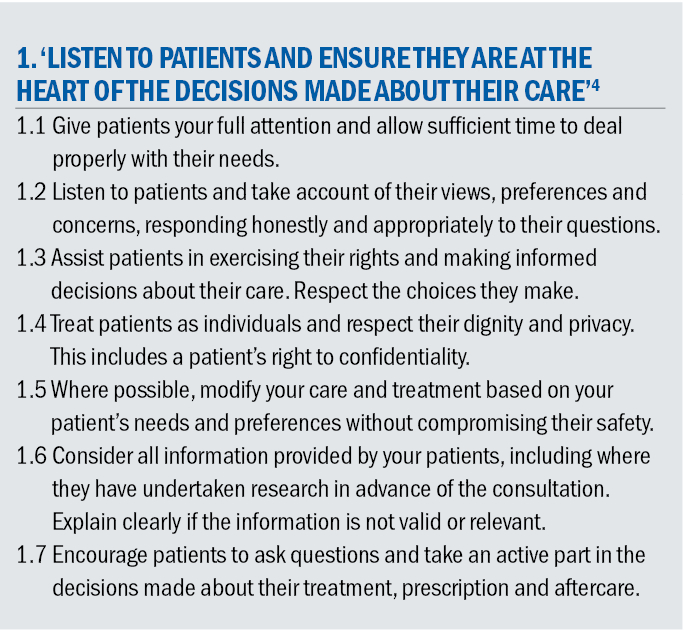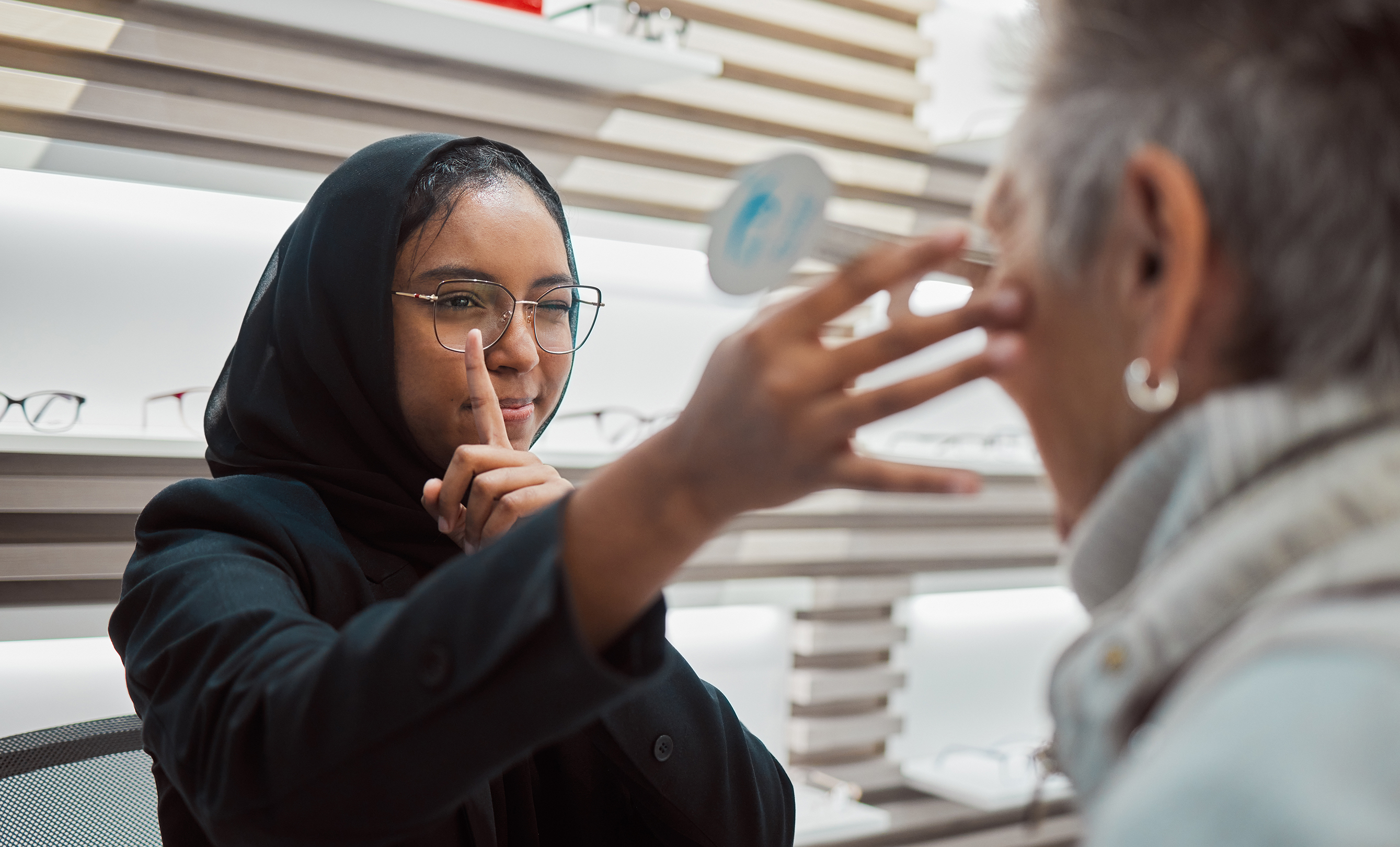
The General Optical Council (GOC) lists at number two in Standards of Practice for optometrists & dispensing opticians: ‘Communicate effectively with your patients’,1 it clearly set out what is expected of registrant staff within optical practice. Conventional wisdom would expect that these standards of practice are adopted by all staff working within the optical practice to ensure patient-centred care.
Communication within optical practice is of the utmost importance to ensure safe and professional interactions between staff members and between staff and patients. For communication to be effective we, as eye care professionals, must adopt strategies that enable us to build relationships within the practice team to deliver a high standard of patient care to a wide range of patient groups and we should be able to tailor our communication to each and every individual we encounter.
This CPD article will concentrate on ‘internal practice communication’ between colleagues in optical practice, and between staff and patients. A subsequent article will pick up on external communications including recall strategies, website communications and the use of social media.

What are communication skills?
There is no one definitive answer. This is a question if you asked 100 people you may receive 100 answers. That said, however, most academics will concur that a recurring theme will be that communication skills include the ability for you to understand others and for others to understand you.
This, of course may be face-to-face, on the telephone, and increasingly via video communications – Covid-19 accelerated the use of telemedicine and video calls within the healthcare environment are now almost commonplace.
Communication is not limited to the spoken word within optical practice, but there are numerous other forms of communication – written, typed or even body language. You might need to communicate ideas, feelings or what is going on around you.
Optical professionals are called upon to communicate ideas to others clearly, in a friendly and confident demeanour, and, by respecting other points of view especially when speaking in a public setting.
Communication skills involve listening, speaking, observing and empathising. The skills are important whether you are speaking face-to-face, on a video call or through letters and emails.
Increasingly today in optical practice, external communications with patients are of paramount importance too – how we are perceived by our patients may make the difference between them choosing to consult us or looking to someone else.2
Communication between the practice team
Effective communication is essential for both individual and team success as it can help you reduce misunderstandings, develop strong relationships, and establish yourself as an active team member.
Learning to communicate effectively requires time and practice to master. It is important to understand what to say and how to say it so you can contribute to collaborative efforts in the workplace and help the organisation reach its objectives.
How a team communicates cannot be underestimated, it sets the tone for the environment. A cohesive, well-trained team enables all within it to participate in the delivery of services and regardless of role, contribute to the overall experience for patients and achieve job satisfaction (figure 1).
Figure 1: Body language plays a role in communication

Interpersonal skills
Like any skill, your interpersonal communication skills can be improved through learning and practice.3
Verbal communication
Verbal communication is a skill that can be practised every day because you will likely interact with various people throughout your day. Every interaction you have with others where you speak is an opportunity.
- Think before you speak: It is important that you do not just say the first thing that comes to mind when speaking to other people. Take your time and think about what you are going to say.
- Be aware of your tone: Your tone makes a big difference to your verbal communication. Be aware of how you speak to ensure your message is not received in the wrong way.
- Breathe: Take pauses when you are speaking to others, especially in longer conversations. Take a breath between sentences to contemplate what you are saying and you will speak more fluently.
- Learn from others: Oftentimes, it is helpful to observe the speaking style of well-known speakers and people you look up to. It can help to imitate aspects of their speaking style to improve your own.
Non-verbal communication
Improving your non-verbal communication is sometimes more challenging than improving your verbal communication skills because it requires you to be aware of both your conscious and unconscious non-verbal expressions.
- Be aware: It is important to be aware of what you are doing with your body while you are speaking. It is easier to adjust your non-verbal communication if you are observant of your habits and body language while you communicate.
- Observe others: Take the time to watch others while they speak, especially people you consider to be good communicators. Look at their body language and facial expressions and try to emulate that when you communicate.
- Make eye contact: Eye contact is a great way to connect with people while communicating, but it can be difficult to know the appropriate amount sometimes. Try to make attentive eye contact with others when they are speaking to you, and ensure you are still attentive to them when it is your turn to speak.
- Relax: Oftentimes, when feeling uncomfortable communicating, we become tense. Take a deep breath and relax your body. This can help you convey your message more effectively.
- Ask others: You may be completely unaware that you have certain traits. Ask others to observe you and identify any mannerisms or gestures that could be misinterpreted. Strive to correct any negative body language to improve your non-verbal communication.

Listening skills
Improving your listening skills can be done any time you communicate with someone.
- Pay attention: It is easy to be distracted, especially when you have a lot to do. To listen better, make an effort to pay full attention to everything the other person has to say.
- Don’t ignore body language: An important part of active listening is incorporating a person’s non-verbal expressions into your understanding of what they have to say.
- Don’t just wait for your turn to speak: It is easy to focus on your response, especially in a heated discussion. Stay focused on listening to what the other person has to say, do not spend your time preparing to respond.
- Confirm what you heard: It is useful to confirm what you heard by repeating aspects of it back to the speaker, especially if there are any aspects you are not clear on or if you are having an emotional reaction to their words.
The General Optical Council in their standards of practice for optometrists and dispensing opticians also state that registrants must: “Listen to patients and ensure they are at the heart of the decisions made about their care.”4
Above all else, use the GOC standards of practice as your template for the provision of effective communication. Use this as the minimum standard of service delivery to your patients and colleagues.
Why is communication important?
Effective communication is essential for both individual and team success as it can help you reduce misunderstandings, develop strong relationships, and establish yourself as an active team member.
Learning to communicate effectively requires time and practice to master. It is important to understand what to say and how to say it, so you can contribute to collaborative efforts in the workplace and help the organisation reach its objectives.
Effective communication can help improve work relationships and make teams stronger. It is essential for a team leader to possess excellent communication skills and regularly get in touch with employees and clients to ensure they are happy.
In addition, communication is often the best way to resolve a conflict between two or more people. Communication can even help you increase productivity at work.
Increased collaboration and engagement
Most optical practices require people to work in teams, increased communication can enhance employee engagement and productivity. It can also help employees feel valued as key contributors to an organisation’s future.
They may then be more willing to increase their efforts towards making a difference in the company. This can lead to higher productivity, retention and customer loyalty.
Improved productivity
Effective communication can also help employees understand their roles and perform their duties better, increasing productivity for the organisation. Employees may also prefer to seek guidance from a communicative leader.
A manager’s guidance can help save the team time and resources that members may normally require to complete a project, help employees feel comfortable carrying out their job duties and show the employees that they are a valuable part of the team.
Increased morale
Effective communication can also prevent productivity losses due to low morale. When teams are highly motivated, they can positively influence others to work harder and increase productivity.
It is important to keep team members aware of their influence on the overall success of the business so they can take pride in their work and be more energetic in the workplace. The organisational culture within any optical practice can have a positive, and sadly, a negative impact on the whole team and patients alike.
Greater loyalty
Increasing communication and treating your employees well can foster loyalty. When employees feel valued and important to the organisation, they may work longer for the company. This can strengthen the company and positively affect its goals.
In addition, with their many years of experience in your company, increased knowledge of workplace operations and familiarity with the industry, employees are more likely to be able to effectively solve problems. Similarly with patients. If they are valued and their experience is positive, they are more likely to remain loyal.
The phrase ‘people buy people’ has been around for decades and is still accepted as a universal truth. It is attributed to Bob Burg, from his 1993 book Endless Referrals.5
Fewer workplace conflicts
One of the best ways to resolve conflicts in a workplace is by ensuring proper communication among employees. Limited communication can lead to hostile work environments. Ensure that your teams communicate regularly to prevent misunderstandings between managers and employees. This can include setting up talk sessions, listening carefully and being empathetic to others.
Greater motivation
People often feel motivated when they understand the background of a company and the benefits of the work they do. By helping them understand why they should work harder, employees can feel motivated to share more ideas and better perform their duties. Seek to understand the reason behind an employee’s lack of motivation to find out how you can help them.
Other considerations of importance
Communication within an optical practice, whether between colleagues, or between staff members and patients is of paramount importance and is not limited to the skills and knowledge detailed above. Turning again to the Standards of Practice many other values and ideals need to be considered, for all, but especially for registrants.
Standards relating to (but not limited to) consent, showing care and compassion for your patients, collaborative working, maintaining confidentiality and respecting privacy, being honest and trustworthy, and being candid when things go wrong are but a few. We will now look at some of these standards in more detail.6
Consent
Consent is a concept that is easy to assume is given freely because patients choose to consult us, however, we must, as optical professionals ensure that consent is given before we embark on any interaction with our patients.7
The NHS defines consent as:
“Consent to treatment means a person must give permission before they receive any type of medical treatment, test or examination.
This must be done on the basis of an explanation by a clinician. Consent from a patient is needed regardless of the procedure,
whether it’s a physical examination or something else.”8
Consent must be given at all stages of the patient journey and to be valid must be given voluntarily. This means the patient must make the decision without any influence, coercion or pressure from staff, family, friends or carers.
Consent must also be informed. This means the person giving the consent should be appraised of the information about what the treatment involves, including the benefits and risks, whether there are reasonable alternative treatments, and what will happen if treatment does not go ahead.
The person giving the consent must also have the capacity to do so, they must be deemed able to give consent. This means they understand the information given to them and can use it to make an informed decision (figure 2).
Figure 2: Consent should be obtained before examining a patient

If an adult has the capacity to make a voluntary and informed decision to consent to or refuse a particular treatment, their decision must be respected.
If this is the case, and all the information has been given, including the consequences of not having the treatment/procedure that is the patient’s right, however, clear contemporaneous records should be made in the patient record in the practice and the patient advised that this is being done.
Consent may be given verbally or in writing. Non-verbal consent could also be given by a patient, for example: tilting their head and holding back their hair to enable you to adjust their spectacles, which are hurting their ear.
If a patient does not have the capacity to consent – there may be many reasons for this such as a brain injury, intoxication, decreased cognition and the like – then the person delivering the care should determine what is in the patient’s best interests. There are many important elements to consider, and great discernment is required.
Many patients will have advance decisions and power of attorney in place to enable someone else, such as a family member or carer, to make any decisions on their behalf. Many patients will have formal agreements in place, but will often present in practice with a family member and wish them to be present during all interaction with all practice members.
It is important to be aware of the differences in provision of consent regarding children for example, at 16 years of age a person is deemed by law to have the capacity to consent.9,10
Although, it cannot be assumed that all children under 16 years of age do not have capacity to consent as was established by Gillick v West Norfolk and Wisbech Area Health Authority 1985,11 that a child under 16 has capacity to consent to examination or treatment if they are able to understand the purpose of the examination/treatment and the consequences of non-treatment if refused.
The Association of British Dispensing Opticians12 and the College of Optometrists13 both include guidance regarding capacity to consent for children and young people.
Confidentiality
Confidentiality is something that is fundamental in optical practice. All patient information should be held in compliance with Data Protection Act 2018 and UK General Data Protection Regulations (GDPR).14
GOC standard of practice ‘Maintain confidentiality and respect your patients’ privacy’,15 specifies patient information includes that which is handwritten, digital, visual audio and information retained in memory.
All patient consultations, which includes dispensing, often involve a patient providing personal history or medical information. Consultations should be conducted with an appropriate amount of privacy and the level of privacy may differ for individual patients.
Social media platforms are used daily by most people and discussing any information about a patient is to be avoided even if names are not used as patient confidentiality still applies.16
The NHS also provides guidance that optical practices should also only hold information relevant to the ongoing care and treatment of the patient and patient preferences should be noted within their case notes.
Patients entrust optical practitioners and practices to gather information, often sensitive in nature, to enable them to deliver appropriate patient-centred care. Most patients do this freely and have the confidence that all practice staff will respect their privacy and act appropriately.17
Duty of candour
All optical professionals, and indeed optical practices, operate to extremely high standards, however, sometimes things can go wrong. Duty of candour is a relatively new concept in the optical sector arising from the Francis Enquiry in 2014,18 where poor patient care necessitated a review and the eight UK healthcare regulators agreed the document that all regulated healthcare professions now work to.
Duty of candour is, at its simplest:
‘All healthcare professionals have a professional duty of candour – this is a professional responsibility to be open, honest and
transparent with patients when things go wrong.’19
Being candid is not an admission of guilt, indeed it is being open and honest to patients and sometimes colleagues that something has gone wrong. It is an opportunity to ‘learn form a mistake’ and an opportunity to reflect on current practice and to take steps to remedy any shortcomings in learning.
In conclusion, communication is a huge subject with many facets.
- Fiona Anderson BSc(Hons) FBDO R SMC(Tech) FEAOO is past president of the International Opticians Association, ABDO past president, past chair Optical Confederation, Optometry Scotland member, past Grampian AOC member, EAOO – co-opted trustee, ECOO European Qualifications board member, Renter Warden: Worshipful Company of Spectacle Makers, Worshipful Company of Spectacle Makers Liveryman & Fellow of the European Academy of Optometry & Optics.
- Part two will look at communication externally from the optical practice.
References
- General Optical Council. 2. Communicate effectively with your patients. Standards of Practice for Optometrists and Dispensing Opticians. London: General Optical Council. 2016 p.7
- Indeed. Communication Skills. Available from: https://uk.indeed.com/career-advice/career-development/communication-skills
- Burg Communications Inc. All Things Being Equal. Available from: https://burg.com/2010/04/all-things-being-equal/
- General Optical Council. 1. Listen to patients and ensure they are at the heart of the decisions made about their care. Standards of Practice for Optometrists and Dispensing Opticians. London: General Optical Council. 2016 p.6
- Bob Burg. Endless Referrals 3rd Edn. Maidenhead England. Mcgraw-Hill Education. 2005.
- General Optical Council. Standards of Practice for Optometrists and Dispensing Opticians. London: General Optical Council. 2016
- General Optical Council. Supplementary guidance on consent. Standards of Practice for Optometrists and Dispensing Opticians. Available from: https://optical.org/media/4dibfi3g/supplementary-guidance-on-consent.pdf
- NHS. UK. Consent to treatment. Available from: https://www.nhs.uk/conditions/consent-to-treatment/#:~:text=For%20consent%20to%20be%20valid,capacity%20to%20make%20the%20decision.
- Great Britain. Family Law Reform Act 1969: Chapter 46, Part 1, section 8. [Internet].London. Stationery Office. 1969.Available from: https://www.legislation.gov.uk/ukpga/1969/46/section/8
- Great Britain. Mental Capacity Act 2005: Chapter p, Part 1, Section 1.[Internet]. London. Stationery Office. 2005. Available from: https://www.legislation.gov.uk/ukpga/2005/9/section/1
- Gillick-v-West Norfolk and Wisbech Health Authority [1985].3 ALL ER 402
- Association of British Dispensing Opticians. C7.3.1 Gillick Competence.Advice and Guidelines. Available from: https://www.abdo.org.uk/regulation-and-policy/advice-and-guidelines/updates/c7-3-1-gillick-competence/
- College of Optometrists. C63 Capacity to consent – Children and Young People. Guidance for Professional Practice. Available from: https://www.college-optometrists.org/clinical-guidance/guidance/communication,-partnership-and-teamwork/consent#Capacitytoconsentchildrenandyoungpeople
- Great Britain. Data Protection Act 2018: Chapter 12. London. Stationery Office. 2018. Available from: https://www.legislation.gov.uk/ukpga/2018/12/contents/enacted
- General Optical Council.14.5 Maintain confidentiality and respect yours patients’ privacy. Standards of Practice for Optometrists and Dispensing Opticians. London: General Optical Council. 2016 p.23
- General Optical Council.14.3 Maintain confidentiality and respect yours patients’ privacy. Standards of Practice for Optometrists and Dispensing Opticians. London: General Optical Council. 2016 p.22
- Digital NHS UK Code of practice on confidential information. Available from: https://digital.nhs.uk/data-and-information/looking-after-information/data-security-and-information-governance/codes-of-practice-for-handling-information-in-health-and-care/code-of-practice-on-confidential-information
- Mid Staffordshire NHS Foundation Trust Public Inquiry. (2013). Report of the Mid Staffordshire NHS Foundation Trust Public Inquiry: Executive summary (HC 947). The Stationery Office. https://assets.publishing.service.gov.uk/government/uploads/system/uploads/attachment_data/file/279124/0947.pdf
- General Optical Council. What is the professional duty of candour. Available from : https://optical.org/media/e0xduxzt/supplementary_guidance_on_the_professional_duty_of_candour.pdf
